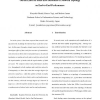Free Online Productivity Tools
i2Speak
i2Symbol
i2OCR
iTex2Img
iWeb2Print
iWeb2Shot
i2Type
iPdf2Split
iPdf2Merge
i2Bopomofo
i2Arabic
i2Style
i2Image
i2PDF
iLatex2Rtf
Sci2ools
SAINT
2007
IEEE
2007
IEEE
On the Effect of Scale-Free Structure of Network Topology on End-to-End Performance
In recent years, it has been reported that several existing networks including the Internet have scale-free structure. In this paper, through a simple numerical analysis, we investigate effect of the scale-free structure of communication networks on their end-to-end performance. As network topologies, a random network and a scale-free network with the equal number of nodes and the equal number of links are used. We compare end-to-end performance of flows (i.e., throughput) in both random and scale-free networks. Consequently, we show that when the average degree of a network is small (i.e., whah the number of links is small), a scale-free network shows better end-to-end performance. On the contrary, when the average degree of a network is large (i.e., when the number of links is large), we show that a random network shows better end-to-end performance.
End-to-end Performance | Internet Technology | SAINT 2007 | Scale-free Network | Scale-free Structure |
| Added | 04 Jun 2010 |
| Updated | 04 Jun 2010 |
| Type | Conference |
| Year | 2007 |
| Where | SAINT |
| Authors | Hiroyuki Ohsaki, Koutaro Yagi, Makoto Imase |
Comments (0)

